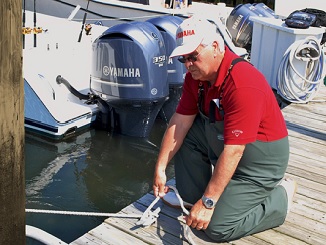 If you spend a little time in docking areas, you’ll be able to identify the novice boaters from the experienced just by watching how they tie up their boat. When you see a shiny new boat pull up to the dock and someone on board throw a few granny knots around a cleat or piling to secure it, there’s a good chance you are observing a new boater in action. Watching someone else struggle to untie their boat because they used an incorrect knot to secure it is another identifier. While most boating courses teach newcomers the basic rules of the road and safe operation of their craft, very few cover ropecraft – and it is an important part of safe boating. Just ask anyone who has watched their boat drift away from the dock and down the river after it was improperly secured, only to watch it hit two other boats before it was rescued by a passing Good Samaritan.
If you spend a little time in docking areas, you’ll be able to identify the novice boaters from the experienced just by watching how they tie up their boat. When you see a shiny new boat pull up to the dock and someone on board throw a few granny knots around a cleat or piling to secure it, there’s a good chance you are observing a new boater in action. Watching someone else struggle to untie their boat because they used an incorrect knot to secure it is another identifier. While most boating courses teach newcomers the basic rules of the road and safe operation of their craft, very few cover ropecraft – and it is an important part of safe boating. Just ask anyone who has watched their boat drift away from the dock and down the river after it was improperly secured, only to watch it hit two other boats before it was rescued by a passing Good Samaritan.
The basic knots used by boaters are all quite simple and easy to learn. With a little practice, they will serve you well both on and off the water. With a few elementary techniques, you will be able to tie more secure knots that are also easy to untie when you are ready to launch your boat.
Cleat Hitch
What could be easier than tying your boat to a cleat when docking? You’d be surprised how many neophyte boaters get this simple procedure wrong. The Cleat Hitch is the proper way to secure a boat to a dock cleat or to secure a line to a cleat aboard the boat when the line does not have a spliced loop on the end.

- Take the line to the ear of the cleat farthest from its opposite end, and take one wrap around the base of the cleat.
- Then make a figure eight across the top of the opposite ear.
- Finish with a simple half hitch turned under so the line is coming away from the cleat in the opposite direction from which it came in.
Bowline
This is an extremely versatile knot that can be used to form a temporary loop in a line, which can then be put over a piling or cleat. It can also be used to attach a line to an eye. What’s nice about the Bowline is it doesn’t slip or jam, which means it’s as easy to untie as it is to tie.

- Make an overhand loop that looks like the number 6, and then bring the end back up through the hole in the 6. Adjust the length of the line for the size of the loop you want to make.
- Wrap the end of the line around the back of the standing line.
- Pass the end back down through the hole in the 6 in the opposite direction and give it a pull to snug the knot tight.
Reef Knot
The reef knot (nautical name) is also known as the square knot. It is a light duty knot for tying two pieces of rope together of similar or different diameters. It is one of the simplest knots to tie, but one misstep and you end up with a granny knot, which is not as strong and can be a pain to untie once it is cinched tight and put under pressure.

- Wrap the two pieces of line together left over right.
- With the ends of the two lines in your hands wrap the right over left.
- Pull the two standing lines tight and it’s done. To untie, just hold both standing and tag lines in opposite hands and push them toward each other to loosen.
Clove Hitch
This knot is used to tie a line around a piling for temporary docking. It’s very easy to tie and will not jam tight when the boat pulls on it making removal fast and easy. To untie, push the tag end while pulling the last loop, and you can unwrap it in a couple seconds.

- Wrap the line around a piling or pole, and bring the end back around and over the standing line.
- Pass the line around the piling or pole again on the opposite side.
- Slip the end under the line as shown and it’s done. If you plan on staying tied up for any length of time, add a couple half hitches with the tag end around the standing line for added security.
Double Half Hitch
This simple knot is used when setting up a permanent slip for a boat and can be tied to pilings or metal mooring rings. It offers a more secure connection than the Clove Hitch and is recommended for boats that will be rocking in their slips for weeks or months on end. It’s a little more difficult to get untied, but the added security is worth the time.

- Take two full turns around the piling or ring so the line won’t slip.
- Make the first hitch by passing the tag end around the standing line and back through.
- Make the second hitch exactly the same way; tighten by pulling the tag end while sliding the hitches down to the wraps.

